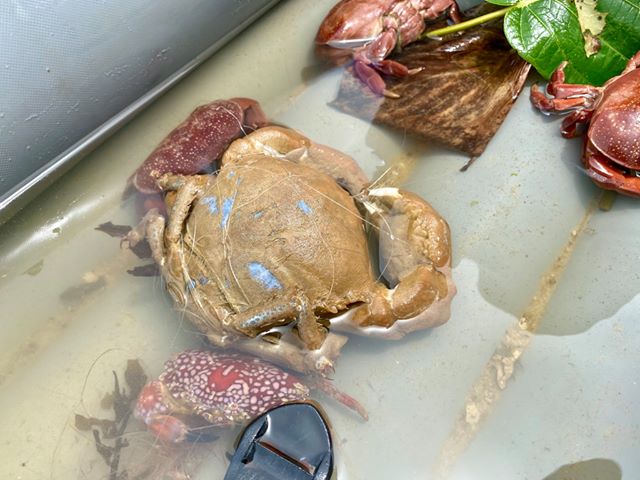Abandoned fishing nets are a real threat to marine life, and three kayakers' trip off Singapore's offshore islands on Aug. 6 transformed into a rescue mission of sorts.
The three kayakers included Huey, the founder of Kayakasia, a local organisation that conducts kayaking tours around Singapore's waters, and two other participants.
Came across large net entangled in seaweed and crustaceans
Huey told Mothership that they had been paddling to Kusu Island when they came across a long abandoned drift net at Tekukor Island, one of the Southern Islands.
As it was low tide at the time, they spotted the net which was weighed down by bricks.
Stretching over 30m long, Huey noted that numerous marine creatures such as crabs, lobsters and corals were trapped in the tangled mess.
 Photo from Kayakasia
Photo from Kayakasia
Huey said the sight of abandoned fishing nets is not an uncommon one, and oftentimes, kayakers like himself would remove the nets and dispose of them elsewhere so as not to endanger other marine creatures.
Occasionally, the nets, being waterlogged and filled with seaweed and other objects, are too heavy for a single kayaker to handle.
A single net could weight over 50kg, Heuy revealed.
But this time with three people at the scene, they were able to cut the net up into three sections and subsequently carry it on their kayaks to the neighbouring Kusu Island.
From the photo, a large crab can already be seen entangled in the mass.
 Photo from Kayakasia
Photo from Kayakasia
A call for help
Huey intended to cut free the creatures stuck in the net's confines, but unfortunately, only had one scissors on hand.
Although he had managed to cut free and rescue around 30 live crabs by himself, it was still not easy to completely remove the nets from the critters.
He then decided to send out a call for help via a Facebook post at around 11am.
Upon sending out this "S.O.S.", Huey said the response was "amazing".Five other members of the public showed up with scissors and gloves to lend a hand despite the impromptu call for help.
Sentosa beach patrol staff appeared at Tanjong Beach as well. In total, 10 people helped pitch in to rescue the creatues, which took over an hour of delicate cutting through the fine net.
 Photo from Kayakasia
Photo from Kayakasia
 Photo from Kayakasia
Photo from Kayakasia
Successful release
Meanwhile, the National Parks Board (NParks) advised for the crabs to be released at Tanjong Rimau, a small stretch of sand near Rasa Sentosa hotel.
 Photo from Kayakasia
Photo from Kayakasia
Some of the species include a Giant sponge crab, Red egg crabs, Mosaic reef crabs, and a Saw-Edged spooner crab. These crabs can't be consumed though, as the latter three are poisonous and cannot be consumed.
Giant sponge crab:
 Photo from Kayakasia
Photo from Kayakasia
Red egg crab:
 Photo from Kayakasia
Photo from Kayakasia
Mosaic reef crab:
 Photo from Kayakasia
Photo from Kayakasia
Saw-Edged spooner crab:
 Photo from Kayakasia
Photo from Kayakasia
"So, with spontaneous help from kayakers, NParks, and Sentosa, all the crabs were successfully rescued and released back to the wild," Huey said.
The impact of ghost fishing gear
Abandoned nets such as these, which are labeled as ghost nets. Ghost nets also refer to commercial fishing nets that have been lost and discarded.
Ghost nets are one of the main threats to marine life, by trapping fish, turtles, and dolphins, all of which ultimately die of starvation.
They also smother coral reefs and introduce parasites and other invasive species into the environment.
Not only can ghost nets devastate the ecosystem where they are discarded, but they can also drift along with the currents and affect marine life far from their point of origin as well.
The durability of the nets further contributes to the difficulty of their removal and retrieval.
Top photo from Kayakasia
If you like what you read, follow us on Facebook, Instagram, Twitter and Telegram to get the latest updates.
